Clockify and TimeCamp both track time, but differ in features, usability, and value. Below, I break down where each wins and who they’re best suited for.
Clockify and TimeCamp promise to help you track time, boost productivity, and simplify billing. But choosing the wrong one could leave you stuck with clunky workflows, missing features, or reports that don’t give you the insights you need.
Below, I break down the pros and cons of each platform and highlight which one fits better depending on how your team works, whether you’re managing remote desk-based teams or field-based shift workers.
A note about our method: All product comparisons and verdicts in this guide are based on hands-on testing by our expert team. Every screenshot was taken from real use during our evaluation.
At a Glance: Quick Summary
Clockify stands out with its free plan that offers unlimited users, making it ideal for larger teams looking for basic time tracking and detailed reporting without breaking the bank. However, its interface can feel dated, and it lacks advanced scheduling and task management features.
Meanwhile, TimeCamp offers a clean interface with some unique features like automatic time tracking and a keyword-based time tracker. These are particularly useful for desk-based freelancers and small businesses. While its mobile app and geofence capabilities leave room for improvement, TimeCamp’s straightforward design and reliable time tracking make it a solid choice for smaller teams.
Pricing and Plans
Both Clockify and TimeCamp offer competitive pricing plans, but they differ in the features available at each tier.
| Plan Type | Clockify | TimeCamp |
| Free | $0 Unlimited users, time tracking, projects & tasks, basic reports | $0 Unlimited users, time tracking, unlimited projects, geofencing |
| Starter | Basic $3.99/user/month Adds bulk edits, time audits, breaks, kiosk PINs, and more | Starter $2.99/user/month Includes invoicing, attendance, time-off, and Excel exports |
| Next tier | Standard $5.49/user/month Adds time off, invoicing, approvals, QuickBooks integration, and more | Premium $4.99/user/month Adds budgeting, apps & website tracking, one integration, and unlimited tags |
| Business | Pro $7.99/user/month Adds scheduling, forecasting, expenses, GPS tracking, and more | Ultimate $7.99/user/month Adds timesheet approvals, billing rates, screenshots, and unlimited integrations |
| Enterprise | Enterprise $11.99/user/month Adds SSO, audit log, custom subdomain, and control accounts | Enterprise $11.99/user/month Adds self-hosting, onboarding, private cloud, and custom integrations |
| Enterprise+ | Productivity Suite $12.99/user/month Adds team chat and project management | N/A |
| * All prices show the monthly cost when billed annually as of August 2025. Note: TimeCamp’s pricing varies by location. We’ve used the US pricing for this comparison. However, our testers based in the Middle East saw lower prices for the Starter, Premium, and Ultimate plans. | ||
Both Clockify and TimeCamp offer free plans with free time tracking.
For Clockify, the paid plans add advanced features like scheduling, forecasting, and invoicing. I find that the Pro plan ($7.99/user/month) provides solid value for mid-sized teams looking for time tracking and scheduling functionalities.
TimeCamp‘s Starter plan ($2.99 /user/month) is reasonably priced for small teams, though I think the higher-tier plans provide better value with more features like project budgets and timesheet approvals.
Ultimately, Clockify is a better fit for larger teams requiring advanced scheduling and forecasting tools, while TimeCamp excels in simpler setups and may suit small teams or freelancers with its more affordable pricing structure.
Pros and Cons
Clockify pros ✅
- Clockify’s free plan offers unlimited users, making it a fantastic option for small teams or startups that need basic time tracking without any additional costs.
- The reporting features are detailed, allowing for customizable reports that can be generated based on various parameters, such as client, project, and task.
Clockify cons ❌
- Clockify’s scheduling features are relatively weak and available only in the Pro plan.
- The user interface feels a bit clunky and outdated, which can make navigation less intuitive, especially compared with more modern solutions.
TimeCamp pros ✅
- TimeCamp’s automatic and keyword-based time tracking are standout features, with the ability to automatically log time based on the title of documents or apps being used, reducing manual input for users.
- The pricing is quite affordable, especially for small businesses.
TimeCamp cons ❌
- TimeCamp doesn’t include a native shift or calendar scheduling tool, which makes it less suitable for teams that must assign, manage, or visualize working hours directly in the platform.
- Its geofencing is unreliable: Clock-ins don’t always trigger accurately, and there’s no real-time location visibility for managers. That makes it hard to verify where field work is happening.
Use Cases
Clockify is best for:
- Granular project and task tracking. Teams can assign time to specific tasks, tag entries, and log billable vs. non-billable hours, which is great for agencies or consultants with multiple deliverables.Detailed reporting and oversight. Clockify’s powerful reporting lets managers break down tracked hours by client, task, or team member, which is ideal for audits, billing, or productivity analysis.
TimeCamp is best for:
- Automatic time tracking for desktop workflows. TimeCamp detects app, website, and document usage in the background, making it perfect for users who switch tasks often and forget to start timers.
- Low-friction cost tracking. It’s easy to track time against budgets or billable rates, making TimeCamp a good match for small businesses managing client work or internal costs.
Clockify vs. TimeCamp: Side-by-Side Feature Overview
In this section, I break down the most crucial features of Clockify and TimeCamp, specifically focusing on how each tool performs for both desk-based teams and field-based workers. I highlight strengths and weaknesses based on our team’s testing and user feedback.
Time tracking – Winner: Clockify
Both Clockify and TimeCamp offer excellent time tracking capabilities, but Clockify pulls ahead with its precision and flexibility.
Clockify supports a wide range of time tracking methods, including desktop apps, mobile apps (iOS and Android), and browser extensions (Chrome, Firefox, Edge).
Admins get valuable GPS tracking (Pro plan) for location verification, while employees appreciate the flexibility to start timers from any device. Screenshots and app usage tracking are also available on the desktop app, though these features require desktop use and won’t benefit teams working exclusively on the go.
TimeCamp, while also offering powerful time tracking through mobile apps, has a unique keyword time tracking feature that employees love. It automatically detects apps and webpages, reducing manual input that workers often forget.
TimeCamp offers geofencing. You can set GPS boundaries around job sites so the system can automatically clock workers in and out when they enter or leave the boundaries. Unfortunately, when we tested this feature, the experience was frustrating. The system occasionally triggered outside the set radius or failed to register shifts at all.
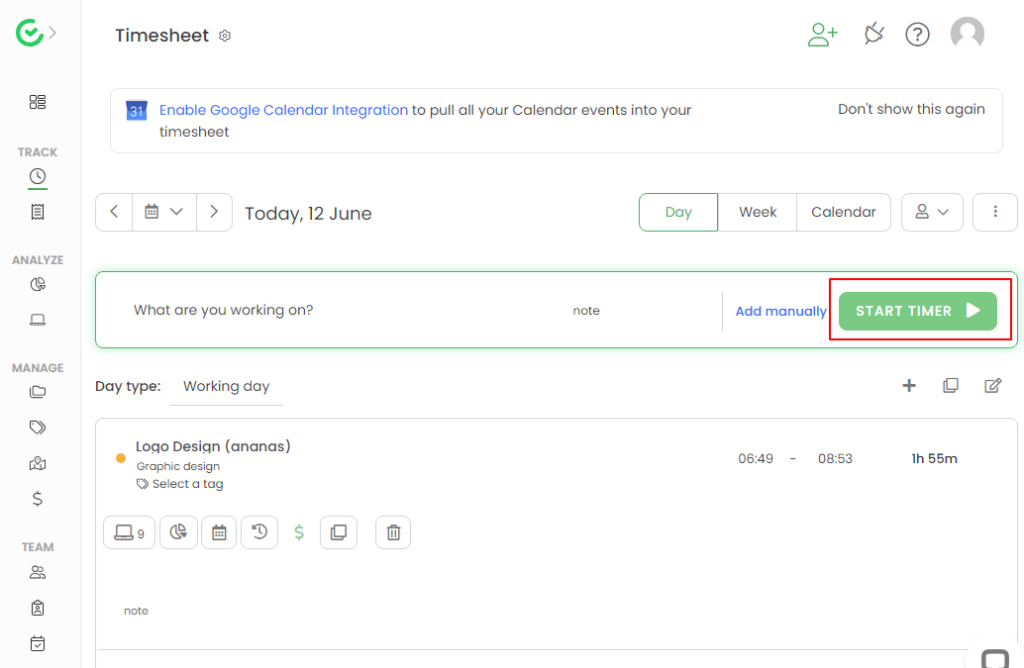
Employee scheduling – Winner: Clockify
Clockify’s Pro plan includes a visual scheduler, allowing managers to assign blocks of time for shifts and tasks quickly. While I found this feature to be more intuitive than TimeCamp’s approach, it’s still not as fully featured as I’d like.
For instance, when we tested it, the lack of a daily view made it harder to view schedules by the hour. There are also no conflict alerts. Plus, employees will wish for more visibility into available shifts and direct shift request capabilities.
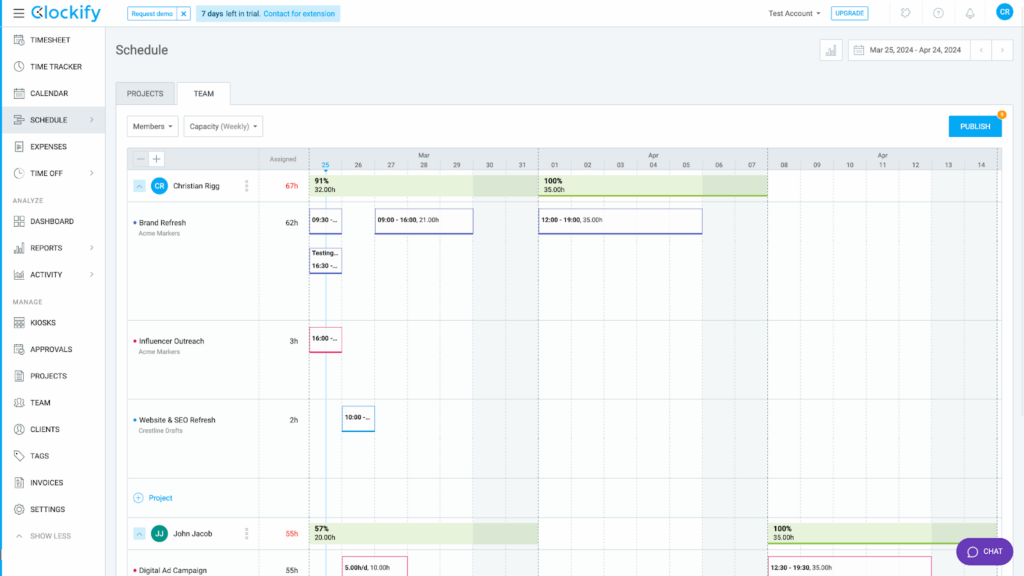
That said, TimeCamp doesn’t offer any native scheduling tool. It does have a Planner module, but it works more like a calendar-based task board with no built-in shift logic, conflict alerts, or availability rules. Planner is also a separate add-on that requires an additional fee. Scheduling can be managed only by using third-party integrations like Trello or Asana, which is a significant drawback for businesses looking for an all-in-one solution (these integrations also aren’t great for shift-oriented businesses that need solid shift scheduling).
We found this inefficient for both admins and employees, who dislike switching between multiple platforms just to check work schedules.
Mobile app – Winner: TimeCamp
Mobile functionality is a crucial factor for field-based teams, and this is where TimeCamp takes the lead.
TimeCamp’s mobile app offers a simple and intuitive interface that allows employees to track time, manage projects, and submit timesheets for approval. I found the mobile app very user-friendly, especially for smaller teams.
Managers can also view tracked time and approve timesheets from the app, though some admin-level functions like invoicing and detailed reporting are only available on desktop.
Clockify’s mobile app supports core employee actions such as tracking time, submitting timesheets, and reviewing entries. But admin-side functionality is limited. We learned that you can’t create schedules or manage reports on the mobile app, making it less useful for making quick decisions while out in the field.
I discovered that admins can still perform key tasks via the mobile website, but this creates a less seamless experience compared with TimeCamp’s app, which offers more essential functions.
PTO and time-off management – Winner: TimeCamp
With Timecamp, workers can request time off directly through the platform. TimeCamp’s PTO management is integrated with the attendance feature, making it easier for managers to track and approve time off requests.
However, our tester found the time off request process a bit clunky, especially on mobile. They noted that submitting a request required too many taps and navigating through inconsistent menus, which could slow things down for busy employees.
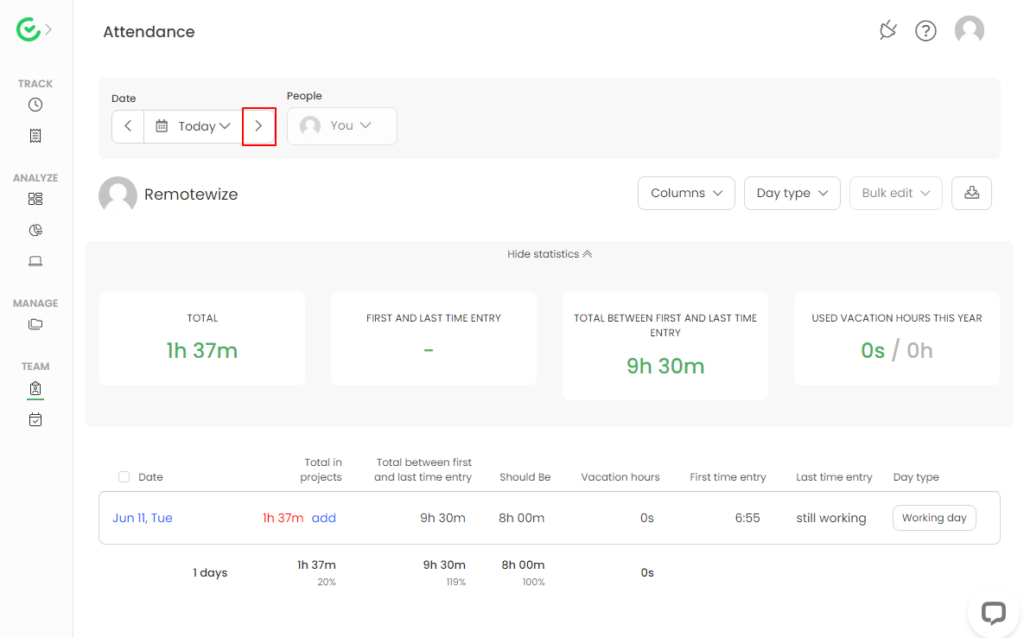
Clockify, while offering time-off tracking in its Pro plan, lacks a more advanced PTO system. While it integrates with the scheduling tool, this integration could use work. During our testing, we were able to assign a shift to an employee who already had approved time off without any warning or conflict alert from the system. That’s a potential issue that could create very unhappy employees.
Additionally, TimeCamp allows teams to customize leave types (e.g., sick days, vacation, unpaid leave) and run reports filtered by type, date range, or user. While TimeCamp integrates these features into its core attendance module, Clockify provides similar abilities through its Time Off module, which is available on its mid- and higher-cost paid plans only.
Reporting and timesheet approvals – Winner: Clockify
With Clockify, managers can create reports based on various filters like client, task, project, or employee.
I appreciate that you can schedule automated reports to be sent via email, making it easy to keep stakeholders informed. The ability to export reports into PDF, Excel, or CSV formats makes it versatile for different business needs.
TimeCamp, while also offering solid reporting features, feels more basic in comparison. It lets users filter data by various metrics, but the reporting capabilities aren’t as extensive as Clockify’s. For instance, there’s no option to build layered reports that combine time data with billing or budget figures. That can limit visibility for finance or operations leads trying to tie hours to cost.
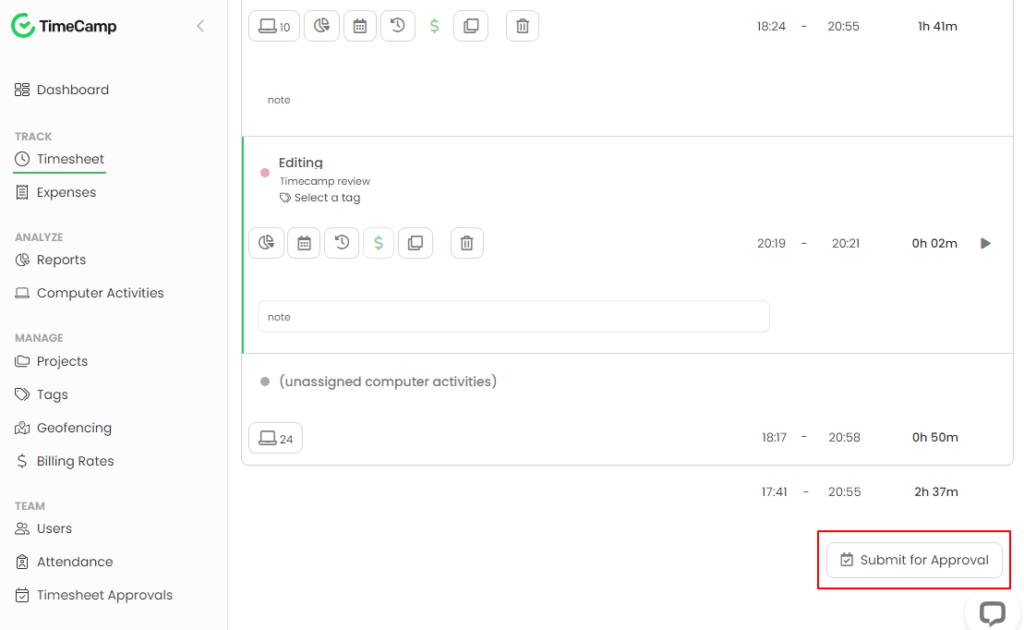
Project & task management – Winner: TimeCamp (slightly)
TimeCamp includes a basic project management module, allowing you to break down projects into tasks and track time against them. It also supports keyword detection, which helps automatically assign time entries to specific projects or tasks.
I found this useful for freelancers or small businesses juggling multiple assignments, even more so for remote or hybrid desk-based teams. While it lacks Gantt charts or task dependencies, it does let you assign descriptions and budgets per project.
That said, TimeCamp’s project tools aren’t as useful in fieldwork scenarios, since workers can’t easily view or update tasks from the mobile app. It’s more suited to supervisors or admins who assign work from behind a desk than to hands-on teams in motion.
Clockify, meanwhile, offers task tracking tied to projects, but it’s very limited. You can’t add task descriptions or files, for instance.
However, it supports integration with tools like Trello, Jira, and Asana, so if you’re already using those, it can serve as a solid time-tracking layer. For field teams, though, that setup might require extra steps or training. I wouldn’t recommend it as a task management tool on its own.
Payroll & billing – Winner: Clockify
Clockify allows you to assign hourly rates per user or task, generate invoices, and export timesheets for payroll. It includes built-in invoicing features, letting you create and download invoices directly from tracked time and expenses. You can also integrate it with QuickBooks Online to sync clients and send billable time entries, though it doesn’t send invoices or handle payroll directly. It’s not perfect, but I’ve found it far more practical for small teams billing clients based on time.
TimeCamp offers comparable features, including rate tracking, invoicing, and payroll-ready exports, though these are limited to its higher-tier plans. It also supports custom integrations for billing and payroll. However, from what I’ve seen, these often require developer involvement, which adds complexity. TimeCamp may be better suited for teams with more technical resources or those already invested in its broader ecosystem.
Clockify is the better plug-and-play option here, especially if you’re billing clients for hours worked and want something that works right out of the box..
Integrations – Winner: Clockify
Clockify integrates with a wide range of project management tools like Asana, Trello, and Jira, as well as accounting tools like QuickBooks and Xero. I found that Clockify’s integrations can be a lifesaver for teams that rely on third-party tools for tasks like invoicing and project tracking.
TimeCamp, while also offering integrations with tools like Asana and Trello, has fewer options compared with Clockify. We found that its integrations are often limited to the Premium or Ultimate plans, which makes it less appealing for teams on lower-tier pricing plans who may need access to multiple tools.
User Ratings
Users generally speak highly of both tools, especially when it comes to ease of use and essential time tracking features.
Clockify
TimeCamp
Security & Compliance
Clockify and TimeCamp take data security and privacy seriously, ensuring that sensitive information is well-protected. Both platforms use data encryption to secure data in transit and at rest.
| Category | Clockify | TimeCamp |
| Data Encryption | ✅ | ✅ |
| GDPR Compliant | ✅ | ✅ |
| Hosting Region | US/EU | US/EU |
| Two-factor Authentication (2FA) | ✅ | ✅ |
| Certifications (SOC 2, ISO, HIPAA) | ISO/IEC 27001 | HIPAA, GDPR |
Clockify is certified under ISO/IEC 27001, and TimeCamp adheres to HIPAA and GDPR, making both platforms suitable for businesses in industries with strict compliance needs.
Both tools also support two-factor authentication (2FA), adding an extra layer of security for user accounts. Furthermore, both have data hosting available in the US and EU, ensuring that they comply with regional data protection laws like GDPR.
Setup and Onboarding
Clockify offers a clean and fast setup process. You can start clocking in within minutes, and the UI is simple enough that most users won’t need walkthroughs.
That said, once you get into more advanced tools like forecasting, scheduling, or setting up manager roles, the learning curve becomes noticeable. While the help center includes useful guides and videos, I think the deeper features would benefit from more hands-on onboarding or tooltips to guide new admins.
TimeCamp also delivers a quick setup, with time tracking available immediately after signup. The layout is user-friendly, and most teams can activate essential features like tracking per task or client, without any tech support.
Invoicing, custom rates, and reporting require a bit more legwork, especially if you plan to use integrations. Onboarding support is available via email and chat, though response times may vary.
Support and Customer Service
Both Clockify and TimeCamp provide essential support channels, with 24/7 chat available for both platforms.
| Support Type | Clockify | TimeCamp |
| 24/7 Chat | ✅ | ✅ |
| Phone Support | ❌ | ✅ |
| Email Support | ✅ | ✅ |
| Help Center | ✅ | ✅ |
However, there are some differences:
- Clockify excels with its responsive chat support, which is available around the clock, ensuring that users can get quick assistance no matter when they need help. However, Clockify doesn’t offer phone support, which I think is a drawback for users who prefer more direct communication.
- TimeCamp offers phone support, making it a better option for teams that require immediate assistance for complex issues. I also found that email support is responsive.
Both platforms provide a help center with articles and guides, which is useful for troubleshooting common problems.
🏆 Who Wins: Clockify or TimeCamp?
| Choose Clockify if you… | Choose TimeCamp if you… |
| Need advanced time tracking features like GPS tracking, screenshots, and integrations with project management tools. | Want a more mobile-friendly solution with easy-to-use time tracking and budgeting for smaller teams. |
| Require strong reporting capabilities with the option to generate detailed and customizable reports. | Prefer an affordable, simple solution that’s ideal for freelancers or small teams with basic tracking needs. |
| Read our in-depth review of Clockify | Read our in-depth review of TimeCamp |
Our take:
If you need power and flexibility, go with Clockify. Its modular features, like GPS tracking, invoicing, and advanced reporting, make it a strong choice for operations-heavy teams that want control over every layer of time tracking.
If you want a no-fuss, affordable solution, TimeCamp may suit you better. With a clean UI, fast setup, and automatic tracking, it’s perfect for freelancers or teams that want to minimize manual time entry without sacrificing accuracy.
Connecteam vs. Clockify vs. TimeCamp
Connecteam isn’t just a time tracker. It’s a workforce management app built for teams that operate in the field, on shifts, or across multiple job sites.
Here’s how it stacks up against Clockify and TimeCamp:
| Feature | Connecteam | Clockify | TimeCamp |
| Time Tracking | ✅ Yes | ✅ Yes | ✅ Yes |
| Scheduling | ✅ Drag-and-drop, shift swaps | ✅ Pro plan only, limited drag-and-drop | ❌ No native scheduler |
| PTO Management | ✅ Built-in with rules & approvals | ✅ Pro plan only, basic setup | ✅ Included but clunky on mobile |
| Free Plan | ✅ Up to 10 users, all features | ✅ Unlimited users, limited features | ✅ Unlimited users, limited features |
| Support | ✅ 24/7 live chat | ✅ Email/chat only, no 24/7 | ✅Live agent not always available |
| Compliance Ready | ✅ SOC 2, ISO, GDPR | ✅ ISO 27001, GDPR | ✅ HIPAA, GDPR, TLS Encryption |
| Integrations | ✅ 30+ apps, including payroll | ✅ Many, including QuickBooks, Asana, and Trello | ✅ Fewer (some custom-built only) |
| Custom Forms/Tasks | ✅ Yes, fully customizable | ❌ | ❌ |
Time tracking with smart rules and location awareness
Connecteam’s time tracking is flexible but controlled. Employees clock in via mobile or desktop with a built-in employee time clock, while admins can restrict clock-ins to specific times, shifts, or job sites. Rules like auto clock-out, early clock-in prevention, and schedule enforcement help reduce timesheet errors.
GPS tracking adds accountability. I like how simple it is to set up geofenced job sites and even see workers’ real-time location data. With Connecteam’s breadcrumbs feature, you can even see how they moved throughout their shifts on a map. Compared with Clockify’s and TimeCamp’s basic GPS features, Connecteam’s setup gives managers more oversight where it counts.
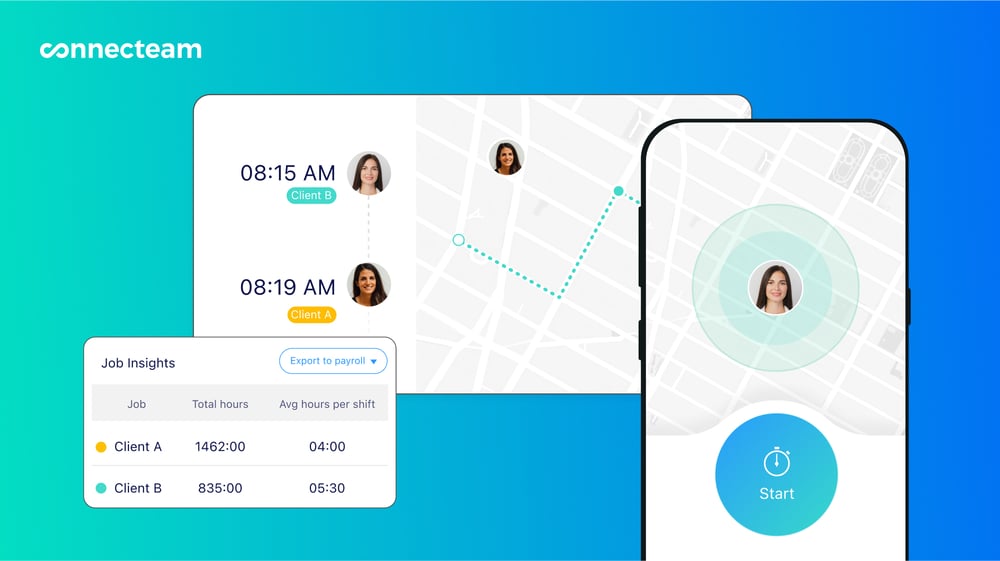
Scheduling that’s actually useful
Connecteam includes a full-featured employee scheduler, unlike TimeCamp (which lacks one) or Clockify (where it’s gated). You can drag and drop shifts, add shift-specific notes or tasks, and enable shift swaps and conflict warnings.
The standout for me was auto-scheduling, which fills open shifts automatically based on skills and availability. It’s especially helpful for rotating teams.
Built-in PTO and break management
Connecteam’s time off management lets you define custom PTO policies, accruals, and approval flows, right inside the app. Employees request time off through their phones, and managers can approve or decline with a tap.
In contrast, Clockify offers limited PTO features on paid plans, while TimeCamp includes it but lacks mobile-friendly controls or in-app approvals.
Breaks are just as configurable: You can set rules for paid vs. unpaid breaks, enforce hour limits, and feed everything into payroll-ready timesheets.
Payroll, timesheets, and approvals
Connecteam’s timesheet dashboard is built for managers. You can bulk-approve shifts, flag errors, and export timesheets to QuickBooks, Gusto, or other payroll systems.
You can also assign hourly rates by role or task, and tag time entries by job, customer, or cost center.
While Clockify and TimeCamp both support payroll exports, Connecteam makes it easier to manage payroll at scale, with fewer steps and better built-in compliance controls.
Task management and forms
Tasks in Connecteam aren’t just time labels; they’re trackable assignments. Add due dates, checklists, files, or instructions, and link them to shifts or assign them independently. I found this great for keeping field teams accountable.
It also includes custom digital forms and checklists, something neither Clockify nor TimeCamp offers. You can collect safety reports, job site checklists, or any workflow data your team needs.
Communication & collaboration
Clockify and TimeCamp don’t offer built-in communication, but Connecteam does. You can message 1:1 or in groups through online team chat, send announcements, attach files, and even track whether updates were read.

Customer support
Connecteam stands out in this category. It offers fast, responsive customer support on all plans, including the free one.
But where it really shines is its paid Connecteam Pros plan, which connects you with certified onboarding experts who help set up and customize your account based on your business structure. For $50/hour, you get tailored help across scheduling, time tracking, forms, onboarding, and more. I really like that this service exists; it turns setup from a guessing game into a guided experience with real impact.
Clockify and TimeCamp offer standard live chat or email support, mostly gated behind paid tiers. In my experience, responses are slower, and there’s less guidance available if you’re trying to fully optimize or customize your setup. There’s no equivalent to Connecteam’s Pros onboarding service.
Overall verdict
Unlike Clockify and TimeCamp, Connecteam gives you the flexibility to scale without hitting feature walls or paying separately for essential workforce management tools. If you’re managing a deskless team and want one comprehensive solution that handles time tracking, scheduling, communication, and compliance without the complexity, Connecteam is the clear winner.
Connecteam also offers a free plan, making it accessible for small teams or those just getting started. And when you’re ready to scale, the paid plan is super affordable: just $29/month for up to 30 users.
FAQs
How do I export from TimeCamp?
To export data from TimeCamp, go to the Reports section, choose your desired report type, date range, and filters, then click Export. You can download the report as a PDF, XLSX, or CSV file.
Does TimeCamp record audio?
No, TimeCamp doesn’t record audio. It tracks time, app usage, and website activity, but it doesn’t access your microphone or capture any sound during monitoring.
Is Clockify 100% free?
Clockify offers a 100% free plan with unlimited users and time tracking. However, advanced features like scheduling, approvals, time off management, and integrations are available only on paid plans.
What is better than Clockify?
Connecteam is better than Clockify for managing deskless or shift-based teams. It offers advanced built-in scheduling, task management, PTO, and communication tools. For freelancers or automation fans, TimeCamp may be better with its keyword-based tracking.

